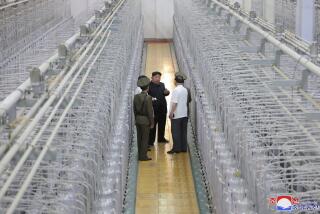S. Korean Experiments With Enriched Uranium Disclosed
- Share via
SEOUL — The U.N. nuclear watchdog is investigating an incident in which South Korean scientists at a large government research institute secretly experimented with highly enriched uranium, nuclear material that could be used in making a bomb.
Although only a minuscule amount of uranium was involved, the revelation could prove highly embarrassing to South Korea and awkward for the United States as it wrestles with the nuclear ambitions of North Korea and Iran.
The South Korean government said Thursday that it had voluntarily reported the experiment to the International Atomic Energy Agency and would ensure that it didn’t happen again.
The Vienna-based IAEA took the information seriously enough to immediately dispatch a seven-member inspection team to South Korea on Sunday. The team is examining the experiments to determine the extent of South Korea’s enrichment effort and the sources of the material and components used in the test.
South Korea is a signatory to the Nuclear Nonproliferation Treaty, which requires countries to notify the IAEA of any work on enriching uranium, which can produce the key ingredient in nuclear bombs.
The experiment took place at the Korea Atomic Energy Research Institute in Taejon over two months in 2000, and immediately afterward the uranium was isolated and the equipment dismantled, the government said.
“This is very much an isolated case. We do not have any enrichment program or reprocessing program,” said Oh Joon, a Foreign Ministry official who deals with the United Nations nuclear agency. “There is no comparison to any other case of noncompliance by some countries, and we do not expect it to have an effect on our efforts to resolve the North Korean nuclear issue.”
A Western diplomat familiar with the investigation said the uranium in question, although small in quantity, was enriched to near weapons-grade.
“They should have told [the IAEA] that they were doing this at the time,” said the diplomat, who requested anonymity because of the sensitivity of the issue. “The IAEA was asking questions for a long time about this site. They probably realized they had to come forward before IAEA inspectors discovered it during an inspection.”
In Washington, State Department spokesman Richard Boucher said the experiment “should not have occurred,” but he noted that South Korea was “cooperating fully and proactively in order to demonstrate that the activity has been eliminated and it is no longer cause for concern.”
The U.N. inspectors are scheduled to give an initial report on their findings Sept. 13 to the IAEA board in Vienna.
Any controversy over the experiment could complicate the U.S.-led effort to halt North Korea’s nuclear program.
Critics could charge the Bush administration with having a double standard in threatening to bring Iran and North Korea -- but not its ally, South Korea -- before the U.N. Security Council. North Korea, which the U.S. alleges has a secret program to enrich uranium, probably will use the South Korean case as an excuse for its own actions.
South Korea’s Science Ministry said Thursday that the experiment was part of a research project using lasers to produce nuclear fuel for civilian use.
“We don’t know yet exactly what South Korea has,” a Seoul-based diplomat said. “If it turns out this was just an ad hoc unofficial project, it should be containable. But at best it is unhelpful that this has happened.”
More to Read
Sign up for Essential California
The most important California stories and recommendations in your inbox every morning.
You may occasionally receive promotional content from the Los Angeles Times.










